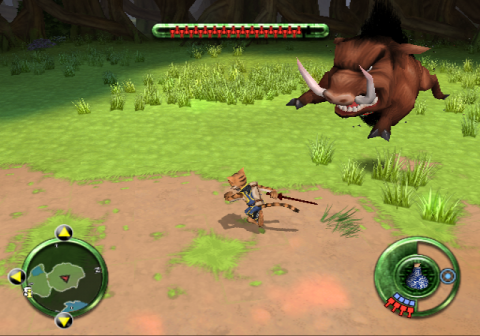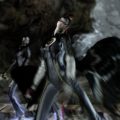- Legend of Kay (Console)
- Legend of Kay (DS)
After years of developing handheld games, German studio NEON Software jumped to consoles with what became their final title. Legend of Kay is an ambitious Asian-inspired action-RPG, with plenty of charm, depth and solid gameplay that make it worth a look for fans of the genre.
Yenching was once a peaceful island where many animals lived in harmony, nourished by the waters of Songstone fountains and a belief in life’s goodness known as The Way. But people have drifted away and the waters have dried up, which was followed soon after by an invasion of armies of gorillas and rats, led by Minister Shun and Tak the Alchemist. A young feisty cat named Kay trains under an old drunken master in an occupied cat village, but when the oppression against his people becomes too much, he sets off to defeat the armies and save Yenching.
Legend of Kay is a 3D action-RPG where you explore, fight enemies and solve numerous puzzles as you accomplish whatever goals open the way to the next area. Since you’re a cat, you have plenty of ways to get about such as jumping, swimming, rope swinging, and even leaping between walls. This means there’s considerably more platforming than usual, though it’s quite manageable due to simple, responsive controls that make it enjoyable to move around.
The combat’s certainly tough, especially on higher difficulties to the point where enemies can feel like damage sponges that overwhelm you in packs. This isn’t helped by the camera, which tries to give a good angle on the action but easily loses track of enemies unless you’re regularly adjusting it. As the game goes on and focuses increasingly on difficult fights, it can become a bit too much if you’re not able to adjust, though there’s plenty of options to help you out.
For a start, you can acquire up to five items to use at any time, including health and magic potions, bombs and hornet swarms to act as crowd control, and a power-up that temporarily strengthens your attacks. These can be found in pots and chests, or bought from nearby shops with coins you’ve obtained from exploring the world, killing enemies and freeing captured animals. There’s also various upgrades to find off the beaten track, such as health and magic increases, suits of armor that protect you for a few hits, and new weapons.
You start off with a sword of average speed and damage, before acquiring fast claws that do lethal damage to unarmored enemies and a slow hammer that knocks off armor easily. You can swap between weapons on the fly, and using the right weapon for the right situation adds an extra layer of strategy to the combat. Even more powerful versions of these weapons lurk in secret areas or act as rewards for completing sidequests, encouraging you to engage with the game to get the most out of it.
In fact, most areas have at least one or two optional missions, which emphasizes the large scope of the adventure despite its linear stage progression. This is further aided by details such as having a fully voiced cast of characters, whose dialogue changes in reaction to major actions you’ve taken in that area, and the density of various locations. Places such as the Meridional Forest and the Forsaken City give you plenty of room to explore and discover, while dungeons often allow you to complete goals in any order. These are complimented by more linear levels, and a handful of racing stages where you ride an animal through a series of checkpoints.
The Marshlands are especially, perhaps exhaustively open-ended with numerous optional challenges and major areas to complete as you see fit. Admittedly, this can result in entering the very difficult and open-ended Frog City without being adequately prepared, so it’s worth keeping a spare save game and turning off the autosave. You can manually save anywhere with up to four save slots (though you’ll return to a checkpoint upon reloading), and there’s options to skip through dialogue, repeated gameplay animations, and even cutscenes if you’d like. You can’t change the difficulty once you’ve started the game, but these are otherwise considerate options for the player.
Considering this was NEON Software’s first fully 3D game, it’s shockingly stuffed with options and things to do, even featuring many bonus features that can be unlocked by acquiring a high amount of points. You do this by collecting colored crystals – red, blue or yellow – and getting enough of the same color increases a multiplier that is kept active by grabbing coins and more crystals. Players interested in getting the most points will want to visit the demonic realms; bonus stages which are accessed only by drinking a special potion in certain areas.
There’s plenty to sink your teeth into, though admittedly it’s the kind of game where you have to enjoy what’s there to begin with. The gameplay is generally quite solid, but doesn’t increase much in complexity apart from the added weapons. You’re not allowed to revisit previous stages, meaning you can miss upgrades and tools that could help you out in potential tight spots (though most of these will eventually appear in the shop). The lives system doesn’t fit the style of game, and having to restart the entire area when you run out is a very harsh punishment for the longer areas.
But the end result is nevertheless an ambitious game that really tries, even when it doesn’t always succeed. The emphasis on story is one of those, utilizing nicely illustrated comic book FMVs and a good deal of dialogue to flesh out what’s still a typical fantasy adventure. The dialogue has some flavor which can occasionally be charming, though this often hinges on the voice acting which ranges from decent to annoying caricatures (the Jamaican accents of the frogs is the most notable example of the latter).
In terms of graphics, Legend of Kay goes for a naturalistic look that compliments the Asian-inspired setting quite nicely, and it features many little details such as lit torches glowing off nearby objects and characters, Kay shaking himself off after he jumps out of the water, and a handful of atmospheric weather effects like fog and light rain. The fast pace of the action is maintained by a steady framerate of 60fps, letting you keep up with what’s going on and to respond in time. It’s also a PAL game that allows you to play at 60hz instead of 50 if your television is compatible, so you can experience the game at its intended speed.
The sound design works at providing appropriate sound effects and ambience for some of the moodier areas, though it’s mostly unremarkable. A genuine surprise is the soundtrack composed by Jake Kaufman, best known for his work on the Shantae and Shovel Knight games alongside countless 8-bit inspired video games. Here, the music uses a faux-orchestral style to create many atmospheric tunes led by melancholic melodies and tense battle tracks. It does a great job at creating a mood, and the number of unique pieces means every step of the journey gets the music it deserves.
Although the game reviewed well upon its release, NEON Software closed in late 2005 as its owner JoWooD Entertainment ran into financial issues. A completely different (and inferior) game with the same name and premise was released for the Nintendo DS in 2010, followed by JoWooD’s closure the next year. That would’ve been it, but all their assets were bought by the then-burgeoning THQ Nordic, who released a 10th anniversary version developed by Kaiko for every major system.
It’s the most easily available version of the game, and thankfully manages to be a straightforward port with the usual additions such as widescreen support and platform-supported achievements. But as par for the course with these kinds of ports, there’s lots of little tweaks and changes that make for a slightly different version rather than a superior port.
Anniversary Edition
The game runs about as well as before, though the models have been retextured and have a greater sheen that makes them resemble action figures. A couple of graphical effects seem to be broken, as certain areas now have much more fog while others like the Frog City have practically none. The UI’s been completely redone with a more minimalist HUD and a comic book-style text font. Sound effects have been largely reworked, though this only amounts to them sounding different, and some of the music tracks now play in other places.
An optional new camera has been introduced which places it lower to the ground and lets you move it up or down. This makes it easier to look at areas below or above you, though it breaks quite badly when you’re wall-jumping. For whatever reason, cutscenes are now presented without text boxes, so you can’t skip lines of dialogue unless you plan on skipping the cutscenes entirely. This makes the cutscenes drag much more than they used to, especially as the subtitles only show you one line at a time.
On a more helpful note, the quest log has been tweaked to distinguish the main missions and side missions, while the map screen between stages shows you how many points you need to unlock the bonuses. Sadly, the biggest change made is the removal of manual saves. Autosaves are the only way the game records your progress now, which not only means you can’t reload an earlier save if you’re in trouble but also that you now have to find the checkpoints to save your game.
Comparisons:
Original
Anniversary
Original
Anniversary
Original
Anniversary


